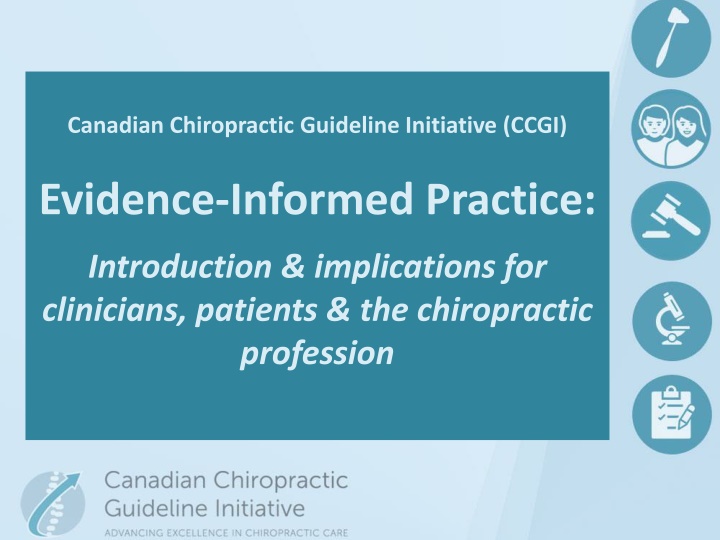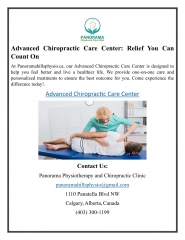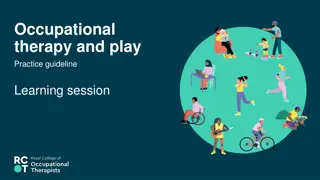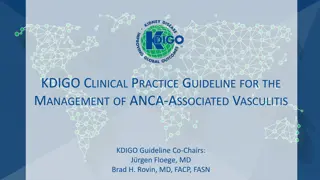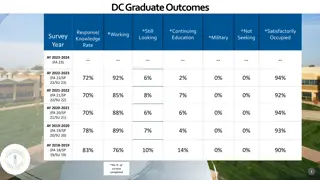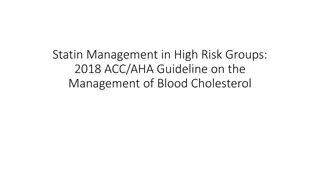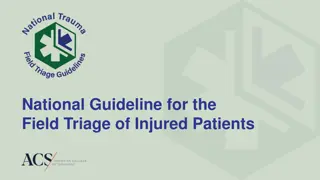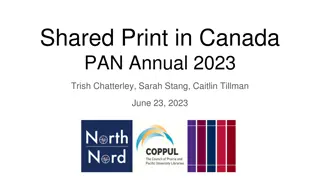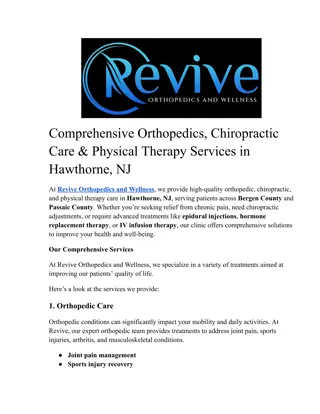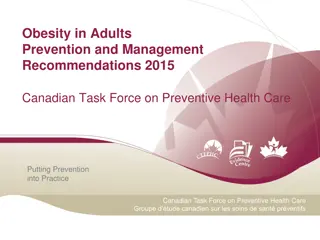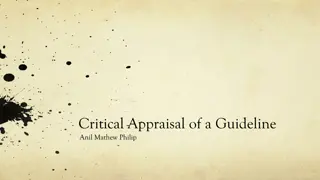Canadian Chiropractic Guideline Initiative: Evidence-Informed Practice
Enhance chiropractic patient care through evidence-based guidelines, addressing top causes of disability like low back pain. Understand the importance of evidence-informed practice in clinical decision-making, incorporating clinical expertise, patient values, and best research evidence.
Download Presentation

Please find below an Image/Link to download the presentation.
The content on the website is provided AS IS for your information and personal use only. It may not be sold, licensed, or shared on other websites without obtaining consent from the author.If you encounter any issues during the download, it is possible that the publisher has removed the file from their server.
You are allowed to download the files provided on this website for personal or commercial use, subject to the condition that they are used lawfully. All files are the property of their respective owners.
The content on the website is provided AS IS for your information and personal use only. It may not be sold, licensed, or shared on other websites without obtaining consent from the author.
E N D
Presentation Transcript
Canadian Chiropractic Guideline Initiative (CCGI) Evidence-Informed Practice: Introduction & implications for clinicians, patients & the chiropractic profession
CCGI Introduction Our Vision: Enhance the health of Canadians by fostering excellence in chiropractic patient care Our Mission: Develop evidence-based CPGs and best practice recommendations Facilitate dissemination & implementation within the chiropractic profession
Top 10 (+1) Causes of Disability (Global Burden of Disease Vos et al. 2012) 1. Low back pain 2. Major depressive disorder 3. Iron-deficiency anaemia 4. Neck pain 5. Chronic obstructive pulmonary disease 6. Other MSK disorders 7. Anxiety disorders 8. Migraine 9. Diabetes 10.Falls 11.Osteoarthritis Musculoskeletal Disorders (MSDs) result in enormous social, psychological & economic burdens (IOM 2011)
Reasons for consulting chiropractors in North America 2% 3% 4% 4% Back pain 6% Upper/Lower extremity problems 42% 14% (Coulter 2005) 25%
Location of patient treatment areas 6% Other 30% Low back region 28% 7% 20% 9% (Waalen & Mior 2005)
WHAT DO YOU THINK OF WHEN YOU HEAR: Evidence-informed practice? Evidence-based medicine? Evidence-informed healthcare?
Evidence-Informed Practice (EIP) CLINICAL DECISION Clinical expertise Clinical context Patient values & preferences Best research evidence The clinical decision involves all three aspects
Evidence-Informed Practice (EIP) Definition: The conscientious, explicit and judicious use of current best evidence in making decisions about the care of individual patients TAKE HOME POINT: Best evidence, clinical expertise and patient values and preferences: all three aspects of the model are equally important!
Evidence-Informed Practice Statement Canadian chiropractors adopt evidence- informed practice principles to guide clinical decision making by integrating their clinical expertise, patient preference and values, and the best available scientific evidence. The EIP statement is approved by colleges and regulatory boards in 9/10 Canadian provinces, and is currently pending approval in Nova Scotia
WHY WOULD YOU USE EVIDENCE- INFORMED PRACTICE?
Why use EIP? chance of positive patient outcomes patient satisfaction risk of harm to the patient Facilitate effective and honest communication with patients Improve cultural authority of chiropractic Enhance integration and communication in multidisciplinary environments Evidence is a common language!
EIP Misconceptions EIP/research = allopathic medicine EIP is a rulebook/cookbook There is no chiropractic research Researchers don t understand practice realities and want to tell us what we can t do vs. what we can/should do Volume of new research is too large, making it impossible to stay current
WHAT ARE SOME BARRIERS TO IMPLEMENTING EIP IN YOUR PRACTICE? WHAT ARE POTENTIAL SOLUTIONS?
Clinician Challenges Lack of time and/or motivation Personal beliefs regarding research: Doesn t reflect my practice/patients Statistics too complex Too much information! Don t know where to look
What is a Clinical Practice Guideline? CPGs are a comprehensive collection of: Current best evidence regarding etiology, diagnosis & treatment of a condition Expert opinion & consensus Practice-based recommendations Who puts these together? Researchers, clinicians and patient reps people we should listen to! It s a massive undertaking!
Clear Question Update & Revise Literature Search Study Selection Dissemination CPG Development Recommendations Critical Appraisal Data Analysis Extraction
Evidence-Informed Practice (EIP) CLINICAL DECISION Clinical expertise Clinical context Patient values & preferences Best research evidence Best research evidence is one part of EIP
CPGs Key Points for Clinicians CPGs are Living EIP documents = updated regularly CPGs are a tool to support clinical reasoning NOT standards of care/practice NOT a substitute for a practitioner s experience CPGs contain practice recommendations linked to best evidence
Summary & Take Home Messages EIP = rational integration of best available research, your clinical experience/expertise and what the patient wants
Summary & Take Home Messages CPGs help guide decision-making regarding diagnosis, treatment and patient management Patients should always be treated as individuals who can have multiple health problems and risk factors humans are complex!
Useful resources on EIP for clinicians
The Canadian Chiropractic Guideline Initiative Website is your essential guide to the latest news on guidelines and best practice www.chiroguidelines.org Visit us today!
EIP interactive learning module CCGI resources include the webinar series and learning modules delivered in collaboration with CMCC Continuing Education offered at no cost to Canadian chiropractors. Look for the module on : Evidence-Informed Practice (EIP)
Connect with your local opinion leaders and best practice collaborators 22 Opinion Leaders are now in place across Canada Over 100 Best Practice Collaborators are joining the program in Spring 2016 Ask them about the evidence-informed practice and best practices
Contact us For any questions please contact us at: ccgisupport@chiropractic.ca www.chiroguidelines.org
Additional resources www.chiroguidelines.org Evidence Informed Practice Program - EIP modules Centre for Evidence-Based Medicine Evidence UP DATES: Free Tools for Evidence-Based Clinical Practice JAMA Evidence Evidence-Based Medicine Tool Kit Grey Matters: A practical search tool for evidence-based medicine Centre for Evidence-Based Medicine (Toronto)
GIG Group Members Project lead: Andr Bussi res Helping practitioners and patients make the right choice for optimal care Clinician 1) Kent Stuber (lead) 2) Jeff Quon (lead) 3) Fadi Al Zoubi 4) Sandy Sajko 5) Simon French (KT Expert) 6) Alex Pessoa (collaborator) Decision Makers 1) Diane Grondin (lead) 2) Simon Brockhusen (collaborator) 3) Andr Bussi res (KT Expert) 4) Michele Maiers (collaborateur) 5) John Triano Chiropractic programs 1) Tony Tibbles (lead) 2) Danica Brousseau (lead) 3) Tue Jensen 4) Aliki Thomas (KT Expert) 5) Craig Jacobs (CMCC collaborator) 6) Joe Lemire (UQTR collaborator) 7) Caroline Poulin (UQTR collaborator) 8)I sabelle Pouliot (UQTR student) Patients 1) Sara Ahmed (lead) 2) Shawn Davies 3) Monika Kastner (KT Expert) 4) Nadia Richer (UQTR collaborator) Any questions? Physical activity: Bob Grisdale (lead) Website- Vic Weatherall (lead) Reviewer: Bryan Budgell
References Coulter ID & Shekelle PG. Chiropractic in North America: Descriptive analysis. J Manipulative Physiol Ther 2005; 28(2): 83-89. Fineout-Overholt E, Mazurek Melnyk B, Schultz A. Transforming Health Care from the Inside Out: Advancing Evidence-Based Practice in the 21st Century. J Professional Nursing. 2005;21(6):335-44. Kawchuk G, Newton G, Srbely J, Passmore S, Bussi res A, Busse JW, Bruno P. Knowledge Transfer within the Canadian Chiropractic Community. Part 2: Narrowing the Evidence-Practice Gap. J Can Chiropr Assoc 2014; 58(3):206-14 (In Press). Lizarondo L, Grimmer-Somers K, Kumar S. A systematic review of the individual determinants of research evidence use in allied health. J Multidisciplinary Healthcare. 2011;4:261-72. Sackett DL, Rosenberg WMC, Gray JAM, Haynes RB, Richardson WS. Evidence based medicine: what it is and what it isn t. BMJ. 1996; 312(7023):71 72. Vos T, Flaxman AD, Naghavi M et al. Years lived with disability (YLDs) for 1160 sequelae of 289 diseases and injuries 1990 2010: a systematic analysis for the Global Burden of Disease Study 2010. Lancet 2012; 380: 2163 96. Waalen JK, Mior SA. Practice patterns of 692 Ontario chiropractors (2000-2001). J Can Chiro Assoc 2005; 49(1): 21-31.
